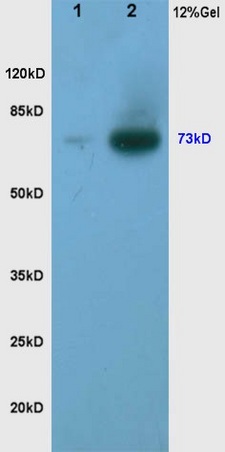
IHC-P analysis of human small intestine tissue using GTX31879 TORC2 antibody. Working concentration : 2.5 microg/ml
TORC2 antibody
GTX31879
ApplicationsWestern Blot, ELISA, ImmunoHistoChemistry, ImmunoHistoChemistry Paraffin
Product group Antibodies
ReactivityHuman, Mouse, Rat
TargetCRTC2
Overview
- SupplierGeneTex
- Product NameTORC2 antibody
- Delivery Days Customer9
- Application Supplier NoteWB: 1 - 2 microg/mL. *Optimal dilutions/concentrations should be determined by the researcher.Not tested in other applications.
- ApplicationsWestern Blot, ELISA, ImmunoHistoChemistry, ImmunoHistoChemistry Paraffin
- CertificationResearch Use Only
- ClonalityPolyclonal
- Concentration1 mg/ml
- ConjugateUnconjugated
- Gene ID200186
- Target nameCRTC2
- Target descriptionCREB regulated transcription coactivator 2
- Target synonymsTORC-2, TORC2, CREB-regulated transcription coactivator 2, transducer of regulated cAMP response element-binding protein (CREB) 2
- HostRabbit
- IsotypeIgG
- Protein IDQ53ET0
- Protein NameCREB-regulated transcription coactivator 2
- Scientific DescriptionThis gene encodes a member of the transducers of regulated cAMP response element-binding protein activity family of transcription coactivators. These proteins promote the transcription of genes targeted by the cAMP response element-binding protein, and therefore play an important role in many cellular processes. Under basal conditions the encoded protein is phosphorylated by AMP-activated protein kinase or the salt-inducible kinases and is sequestered in the cytoplasm. Upon activation by elevated cAMP or calcium, the encoded protein translocates to the nucleus and increases target gene expression. Single nucleotide polymorphisms in this gene may increase the risk of type 2 diabetes. A pseudogene of this gene is located on the long arm of chromosome 5. [provided by RefSeq, Dec 2010]
- ReactivityHuman, Mouse, Rat
- Storage Instruction-20°C or -80°C,2°C to 8°C
- UNSPSC12352203
References
- Lee MY, Chen WC, Hsu WH, et al. Liraglutide Inhibits Hepatitis C Virus Replication Through an AMP Activated Protein Kinase Dependent Mechanism. Int J Mol Sci. 2019,20(18). doi: 10.3390/ijms20184569Read this paper








![FACS analysis of HeLa cells using GTX82754 TORC2 antibody [5B10]. Green : TORC2 Purple : negative control](https://www.genetex.com/upload/website/prouct_img/normal/GTX82754/GTX82754_20170912_FACS_w_23061322_188.webp)




